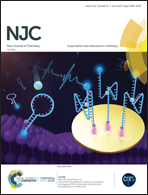First-principles study of the effect of compressive strain on oxygen adsorption in Pd/Ni/Cu-alloy-core@Pd/Ir-alloy-shell catalysts†
Abstract
A palladium-based (Pd-based) core@shell catalyst can be modified to achieve the desired oxygen adsorption properties by selecting an appropriate core composition, surface alloying, and compressive strain. Herein, we present the effects of compressive strain, core composition, and surface alloying in Pd3Ni@PdIr(111), Pd3CuNi@PdIr(111), and Pd3Cu@PdIr(111) alloy-core@alloy-shell catalysts on dioxygen adsorption. Using experimental lattice parameters for the unstrained catalysts, −1% to −5%, strain was systematically introduced. The calculated dioxygen-adsorption energies for the surface Pd and surface Ir atoms reveal that the Pd3CuNi@PdIr catalyst has the lowest dioxygen-adsorption energy at a given compressive strain. Bader charge calculations show that the Pd3CuNi@PdIr catalyst surface is the most charge depleted. The d-band model displays an intermediate d-band center downshift for the surface Pd atoms, and the highest downshift for the surface Ir atoms. Due to synergism between charge depletion, the d-band center shift, and the surface alloy effect, the Pd3CuNi@PdIr catalyst has the lowest dioxygen-adsorption energy. The relationship between the experimentally obtained catalyst-surface mass activity and the theoretically calculated d-band center of the surface Pd and the surface Ir is volcano shaped, with the Pd3CuNi@PdIr catalyst at the apex of the volcano. The catalytic activities of these catalysts were observed to follow the order: Pd3CuNi@PdIr > Pd3Cu@PdIr > Pd3Ni@PdIr. This work sheds light on the importance of ligand and strain effects, as well as surface alloying for the fine-tuning of alloy-core@alloy-shell-catalysts during the rational design of catalysts from first principles.



 Please wait while we load your content...
Please wait while we load your content...